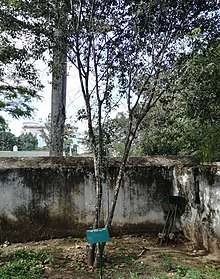Olea hochstetteri
Olea hochstetteri (East African olive, black ironwood)[1] is a species of tree of the family Oleaceae. It is often seen as synonymous with a subspecies of the black ironwood, namely O. c. subsp. macrocarpa,[2] which is however native to Afromontane forest from East to southern Africa. Like the related species Olea welwitschii, it grows in sandy desert regions of Kenya, Tanzania and Uganda. It is an inconspicuous plant that does not attain great height, in contrast to O. welwitschii which can attain a height of 25 metres.
| Olea hochstetteri | |
|---|---|
 | |
| Scientific classification | |
| Kingdom: | |
| (unranked): | |
| (unranked): | |
| (unranked): | |
| Order: | |
| Family: | |
| Genus: | |
| Species: | O. hochstetteri |
| Binomial name | |
| Olea hochstetteri Baker | |
Uses
Both these species are sources of firewood, but the wood is also valued for its prominent veins, similar to that of the European olive though finer in texture.[3] As hardwoods they are considered suitable for flooring, furniture, carving, turning and veneers.[4] The leaves have been used in folk medicine as an antibacterial, a property which has found some support in the laboratory.
References
- "East African Olive Ijzerhout / Black Ironwood". Kenya Natural History Guide. Retrieved 16 December 2014.
- "Olea hochstetteri". Germplasm Resources Information Network (GRIN). Agricultural Research Service (ARS), United States Department of Agriculture (USDA). Retrieved 16 December 2014.
- "*** Trade Name *** Olivewood (African)". Stars Art and Design. Retrieved 16 December 2014.
- The Secret Life of Trees, Colin Tudge. Penguin Books. 2006. p. 243